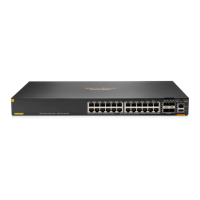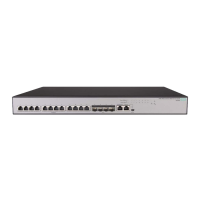374
Step Command Remarks
1. Enter system view.
system-view
N/A
2. Create an OSPF process for
a VPN instance and enter
OSPF view.
ospf
[ process-id |
router-id
router-id |
vpn-instance
vpn-instance-name ] *
Perform this configuration on the
MCE. On a VPN site, create a
common OSPF process.
An OSPF process bound to a VPN
instance does not use the public
network router ID configured in
system view. Therefore, configure
a router ID for the OSPF process.
An OSPF process can belong to
only one VPN instance, but one
VPN instance can use multiple
OSPF processes to advertise
VPN routes.
3. Redistribute remote site
routes advertised by the PE
into OSPF.
import-route
protocol
[ process-id |
all-processes
|
allow-ibgp
] [
allow-direct
|
cost
cost-value |
nssa-only
|
route-policy
route-policy-name |
tag
tag |
type
type ] *
By default, no routes are
redistributed into OSPF.
4. Create an OSPF area and
enter OSPF area view.
area
area-id By default, no OSPF areas exist.
5. Enable OSPF on the
interface attached to the
specified network in the area.
network
ip-address
wildcard-mask
By default, an interface neither
belongs to any area nor runs
OSPF.
562BConfiguring IS-IS between an MCE and a VPN site
An IS-IS process belongs to the public network or a single VPN instance. If you create an IS-IS
process without binding it to a VPN instance, the process belongs to the public network.
Binding IS-IS processes to VPN instances can isolate routes of different VPNs. For more information
about IS-IS, see Layer 3—IP Routing Configuration Guide.
To configure IS-IS between an MCE and a VPN site:
Step Command Remarks
1. Enter system view.
system-view
N/A
2. Create an IS-IS process for a
VPN instance and enter
IS-IS view.
isis
[ process-id ]
vpn-instance
vpn-instance-name
Perform this configuration on the
MCE. On a VPN site, configure a
common IS-IS process.
3. Configure a network entity
title.
network-entity
net By default, no NET is configured.
4. Create the IS-IS IPv4 unicast
address family and enter its
view.
address-family ipv4
[
unicast
]
By default, the IS-IS IPv4 unicast
address family is not created.
5. Redistribute remote site
routes advertised by the PE
into IS-IS.
import-route
protocol
[ process-id |
all-processes
|
allow-ibgp
] [
allow-direct
|
cost
cost-value |
cost-type
{
external
|
internal
} | [
level-1
|
level-1-2
|
level-2
] |
route-policy
route-policy-name |
tag
tag ] *
By default, IS-IS does not
redistribute routes from any other
routing protocol.
If you do not specify the route
level in the command, the
command redistributes routes to
the level-2 routing table by
default.

